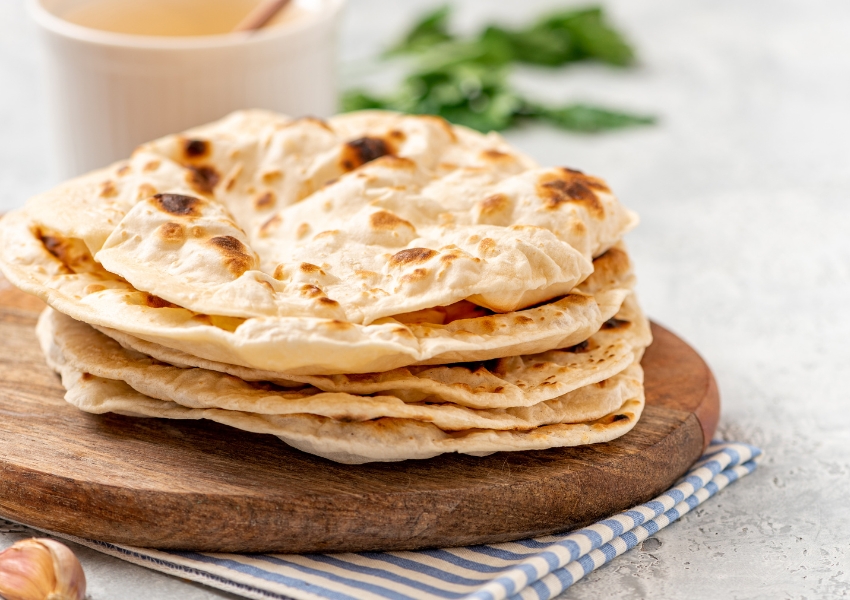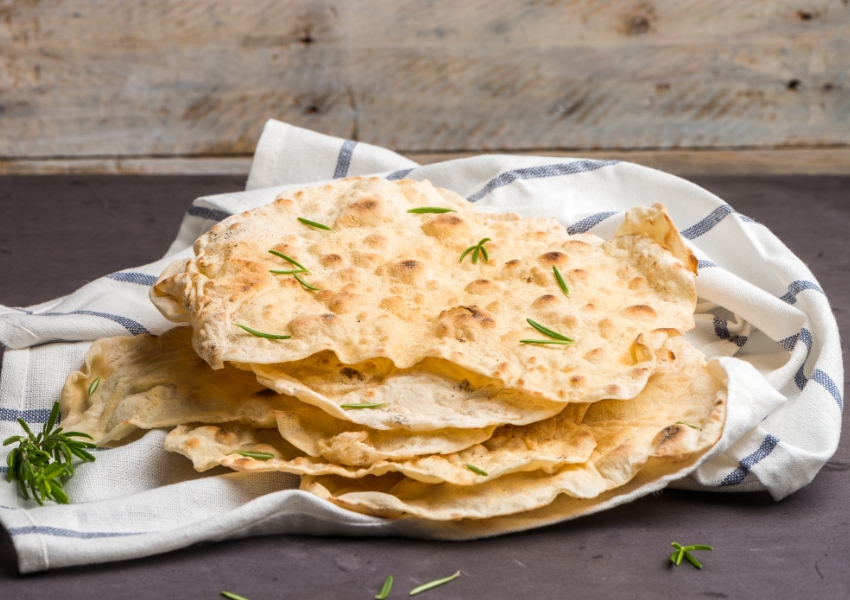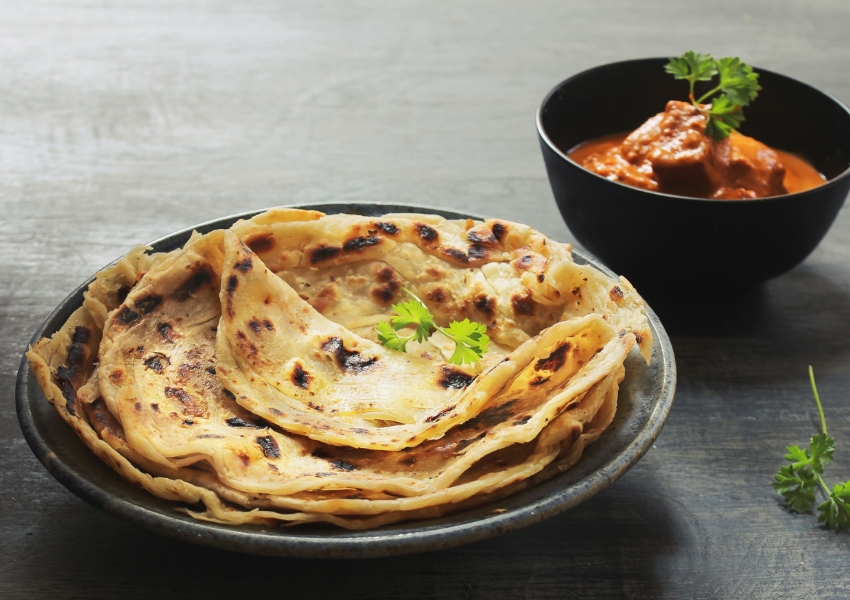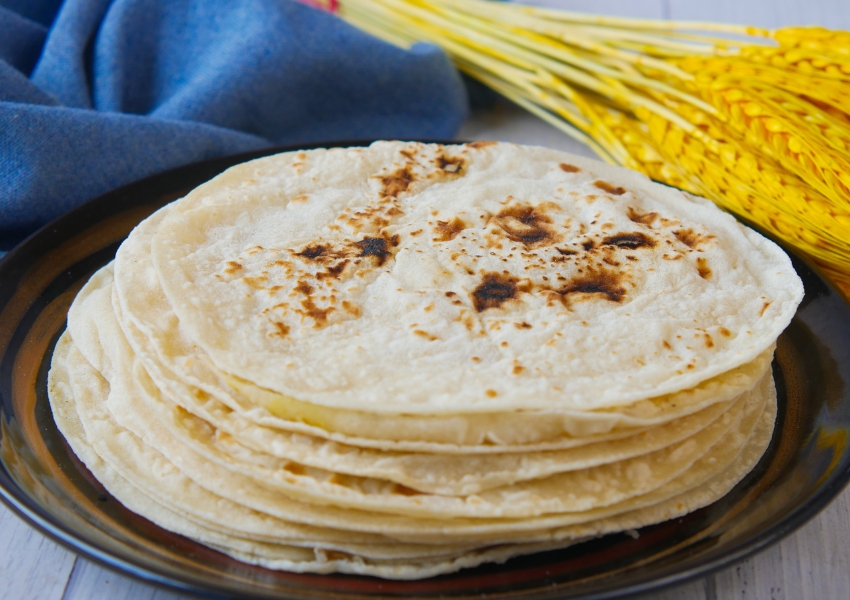If you’ve ever wondered about the calorie content of staple food like Chapati, you’re not alone. Chapati, or Roti, is a popular Indian flatbread made from whole wheat flour. It’s a dietary staple in many households and is often served with various curries, vegetables, and lentils. In this article, we will delve into the nutritional aspects of Chapati and explore how many calories are in one piece.
What is Chapati?
Chapati is an unleavened flatbread that originated from the Indian. It is also known by various names such as Roti and a roshi in different regions. Made from whole-wheat flour called atta, the dough is prepared with water, oil, and salt (optional) using a mixing utensil called a part. The chapatis are then cooked on a flat skillet known as a tava.

This flatbread is a staple in India, Nepal, Bangladesh, Pakistan, Sri Lanka, East Africa, the Arabian Peninsula, and the Caribbean. It has also become a typical food among expatriates from the Indian worldwide. Chapatis were introduced to other parts of the world by immigrants from the Indian, including Indian merchants who brought them to Central Asia, Southeast Asia, East Africa, and the Caribbean islands.
How many calories does 1 Chapati have?
One Chapati contains 104 calories, with carbohydrates contributing 63 calories, proteins providing 10 calories, and fats accounting for the remaining 33 calories. One Chapati fulfills approximately 5 percent of the daily calorie requirement for a standard adult diet of 2,000 calories.
The nutritional profile of one Chapati made from 100% whole wheat flour is as follows: Cholesterol: 0 mg, Carbohydrates: 15.7g, Protein: 2.6g, Fat: 3.7g.
The Chapati is a versatile and popular Indian dish, commonly prepared in Indian households daily. It is an essential part of a meal and can be easily made using ingredients commonly found in Indian kitchens.
To make whole wheat chapati:
- Combine the flour, oil, and salt in a deep bowl and knead them with enough water until you obtain a smooth and soft dough.
- Allow the dough to rest for 15 to 20 minutes.
- Divide the dough into six equal portions and roll each piece into thin circles.
- Cook the Chapati on a non-stick tava, then place it on an open flame until it puffs up.
This method ensures soft chapatis.

Here are some essential tips for making the perfect Chapati:
- Use a deep bowl to prevent ingredients from falling off while mixing or kneading the dough.
- If desired, you can omit to add salt to the chapati dough for a bland taste.
- Gradually add water while kneading the dough to avoid adding too much at once.
- Apply a small amount of oil on the surface of the dough before letting it rest to prevent dryness. Cover the dough with a wet muslin cloth or use a food-grade cling film or plate.
- Allow the dough to rest for 15 minutes as it improves the texture, making it easier to roll and resulting in softer and fluffier chapatis.
Chapatis are enjoyed in various ways, whether paired with subzi and dal, rolled up with grated veggies and cheese, or even spread with jam. Good quality whole wheat flour ensures that the chapatis are healthy and satisfying for adults and children.
Nutritional value of Chapati
| Value per chapatti | % Daily Values | |
| Energy | 104 cal | 5% |
| Protein | 2.6 g | 5% |
| Carbohydrates | 15.7 g | 5% |
| Fiber | 2.6 g | 10% |
| Fat | 3.7 g | 6% |
| Cholesterol | 0 mg | 0% |
| VITAMINS | ||
| Vitamin A | 30.6 mcg | 1% |
| Vitamin B1 (Thiamine) | 0.1 mg | 10% |
| Vitamin B2 (Riboflavin) | 0 mg | 0% |
| Vitamin B3 (Niacin) | 0.9 mg | 7% |
| Vitamin C | 0 mg | 0% |
| Vitamin E | 0.2 mg | 1% |
| Folic Acid (Vitamin B9) | 7.8 mcg | 4% |
| MINERALS | ||
| Calcium | 10.4 mg | 2% |
| Iron | 1.1 mg | 5% |
| Magnesium | 28.6 mg | 8% |
| Phosphorus | 76.9 mg | 13% |
| Sodium | 4.3 mg | 0% |
| Potassium | 68.2 mg | 1% |
| Zinc | 0.5 mg | 5% |
Percent Daily Values are based on a 2000-calorie diet. Your daily values may be higher or lower depending on your calorie needs.
Is Chapati healthy?
Yes, Chapati is considered a healthy food. It is a staple in Indian cuisine and is commonly consumed with dal, sabzi, or achar. The main ingredient of Chapati is whole wheat flour, which offers several health benefits.
- Chapatis are low in calories, making them suitable for individuals on a low-calorie diet or those watching their weight.
- They have a low glycemic index, meaning they do not cause a rapid increase in blood sugar levels. This makes chapatis a good choice for individuals with diabetes.
- Whole wheat flour contains Vitamin B1, which acts as an antioxidant and helps combat free radicals that can harm the body.
- While chapatis are traditionally prepared with a small amount of oil, making them without adding oil during kneading is also possible. This variation can be beneficial for individuals following a low-fat diet or aiming to reduce their overall fat intake.

How many chapatis should be eaten in a day to lose weight?
Typically, a small chapati contains approximately 81 calories. Therefore, if your target calorie intake for lunch is 300 calories, you can have two chapatis, around 160 calories. The remaining calories can be obtained from vegetables and salad alongside the chapatis.
It is important to note that not only chapatis but also the vegetables and fruits you consume contain carbohydrates to some extent.
The number of wheat rotis you can consume daily depends on your overall calorie intake. For weight loss purposes, it is recommended to have four chapatis per day.
If you are following intermittent fasting and considering consuming three chapatis during lunch, consider the calorie intake. Calculate the calorie content of the three chapatis and the calories in the vegetables and salad you consume. If the total calorie intake exceeds 350 calories, it may be advisable to reassess your chapati consumption.
What are the Advantages of eating Chapati?
Chapati is a nutritious staple that offers various health benefits to your daily diet. Some of the critical advantages of consuming chapati include:
- Suitable for individuals with diabetes: Chapati made from whole wheat flour is a beneficial choice for people with diabetes. The presence of minerals like magnesium in wheat helps slow down glucose absorption and increase insulin production. Additionally, zinc and potassium in chapati can help reduce blood sugar levels.
- Improves digestion: Chapati is a rich source of dietary fiber, which aids in improving digestion. The fiber content also promotes a feeling of fullness, preventing overeating. Therefore, chapati is highly recommended for individuals experiencing constipation or other bowel issues.
- Rich in protein, iron, and phosphorus: Chapati is a good source of iron, making it helpful in treating and preventing anemia. It is also rich in protein and contains healthy carbohydrates. Furthermore, chapatis provide a good amount of phosphorus, enhancing calcium absorption to maintain healthy bones. The zinc content in chapati facilitates mineral absorption in the body.
- Boosts energy levels: Chapatis contain complex carbohydrates that sustain energy release, keeping you full for extended periods. This helps reduce unhealthy snacking between meals.
- Benefits of blood pressure: Chapati is recommended for individuals with high blood pressure and cholesterol due to its mineral and vitamin content. These nutrients improve blood circulation and help remove toxins from arteries and veins, reducing plaque buildup and lowering harmful cholesterol levels.
- Enhances skin and hair health: The vitamins, minerals, and fiber in chapati contribute to improving skin and hair quality.
- Low in calories: Chapati is low in calories, making it a suitable option for weight management. The high dietary fiber content helps keep you feeling full for longer, reducing the need for excessive snacking throughout the day.
The 7-Day Chapati Diet Plan for Quick Weight Loss
Chapati Diet Plan: 7-Day Meal Plan
Day 1:
- Breakfast: 1 chapati with 1 cup of low-fat yogurt and a serving of fresh fruit.
- Lunch: 2 chapatis with 1 cup of dal (lentils) and a refreshing salad.
- Dinner: 1 chapati with 1 cup of steamed vegetables and tofu.
Day 2:
- Breakfast: 1 chapati with a delicious combination of scrambled eggs and sautéed vegetables.
- Lunch: 2 chapatis with 1 cup of roasted chicken and a side of colorful vegetables.
- Dinner: 1 chapati with 1 cup of dal (lentils) and a portion of steamed vegetables.
Day 3:
- Breakfast: 1 chapati with a flavorful mix of vegetables and tofu scramble.
- Lunch: 2 chapatis with a tempting chicken curry and a small salad.
- Dinner: 1 chapati with a medley of colorful vegetables and a delightful fish masala.
Day 4:
- Breakfast: 1 chapati topped with peanut butter and a serving of fresh-cut fruits.
- Lunch: 2 chapatis stuffed with chickpeas and vegetables, served with curd.
- Dinner: 1 chapati with a generous portion of tofu and stir-fried vegetables.
Day 5:
- Breakfast: 1 chapati with a delectable veg-egg bhurji (scrambled eggs with vegetables).
- Lunch: 2 chapatis with a savory rajma curry (kidney beans) and salad.
- Dinner: 1 chapati with 1 cup of dal (lentils) and a flavorful mixed vegetable sabzi.
Day 6:
- Breakfast: 1 chapati with a mix of sautéed vegetables and an omelet.
- Lunch: 2 chapatis with a tantalizing stir-fry of chicken and colorful vegetables.
- Dinner: 1 chapati with grilled fish and a medley of mixed vegetables.
Day 7:
- Breakfast: 1 chapati spread with peanut butter and banana slices for a delightful combination.
- Lunch: 2 chapatis with a comforting lentil curry and various mixed vegetables.
- Dinner: 1 chapati paired with grilled tofu and different mixed vegetables.
Note: This diet plan should be followed for one week, accompanied by regular exercise. It is recommended to consult a healthcare professional before starting any new diet or exercise regimen.
How to burn 104 calories that come from one Chapati?
Calorie Burning Activities
To burn approximately 104 calories, you can engage in the following activities:
- Walking at a speed of 6 mph for about 31 minutes.
- Running at a rate of 11 mph for approximately 10 minutes.
- Cycling at a pace of 30 mph for around 14 minutes.
- Swimming at a speed of 2 mph for about 18 minutes.
Please note that these values are approximate, and the actual calorie burning may vary depending on individual factors.
What is the Difference Between Roti, Chapati, Naan, and Paratha?

Roti is a type of flatbread, similar to a tortilla, that can be made using a combination of all-purpose flour and whole wheat flour, resulting in a slightly lighter texture.
On the other hand, Chapatis are a type of Roti typically made solely from whole wheat flour, giving them a more rustic quality. Both Roti and chapatis are cooked without the use of oil.
Paratha is another variety of Roti made with whole wheat flour and cooked with oil. This cooking method gives parathas a softer interior texture with crispy edges.
Traditional naan, unlike Roti and chapatis, is made using white flour. It has a softer and chewier texture. Traditionally, naan is cooked on the side of a tandoori oven. Still, it can also be prepared in a dry skillet like Roti or chapatis on a grill or baked in an oven to achieve its characteristic puffiness.
Types of Chapati Diets for Speedy Weight Loss
There is no specific “Chapati Diet” designed for rapid weight loss. However, there are various ways to include Chapati in a healthy weight-loss diet. Here are some suggestions:
- Whole Wheat Chapati Diet: Consuming whole wheat chapatis made with atta (whole wheat flour) can provide a good source of fiber, protein, and complex carbohydrates, supporting weight loss. Pair them with vegetables and lean protein sources like grilled chicken or fish.
- Multigrain Chapati Diet: Multigrain chapatis made from a mix of whole grains like wheat, rye, oats, and barley offer a variety of nutrients. They can be paired with healthy toppings such as avocado, hummus, or tofu. Due to their high fiber content and nutrient profile, they are a suitable choice for weight loss.
- Oat Chapati Diet: Oat chapatis made from whole oat flour is a healthier alternative to regular wheat chapatis. They are rich in fiber, protein, and healthy carbohydrates. Fiber aids in weight loss and promotes satiety. Pair oat chapatis with protein-rich toppings like eggs, cottage cheese, or lentils for a balanced meal.
- Low-fat Chapati Diet: You can make low-fat chapatis by using less oil during cooking or opting for oil-free cooking methods like grilling or baking. Pair these chapatis with low-fat toppings such as grilled vegetables for a balanced and healthy meal.
- Low-calorie Chapati Diet: Incorporate chapatis from low-calorie flours like millet, ragi, or bajra into your diet. These flours are rich in fiber and nutrients, making them suitable for weight loss. Create a diet plan that includes low-calorie chapatis and a variety of vegetables, lean proteins, and healthy fats for effective weight loss.
Alternative Flour Options Can Turn Your Regular Chapati into a Weight-Loss Friendly Food
According to the Food and nutrition organization, various types of flour can be used to make chapatis, each with its unique nutritional profile and potential health benefits. Here are some weight-loss-friendly options for making chapatis:
- Whole Wheat Flour: Whole wheat flour is a healthier alternative to regular all-purpose flour as it is high,, and nutrients. It can help maintain a healthy weight and support weight loss efforts.
- Oat Flour: Oat flour is a nutritious and low-calorie option that can substitute for regular flour in chapatis. It is rich in protein and fiber, promoting satiety and aiding in weight loss.
- Buckwheat Flour: Buckwheat flour is a gluten-free option high in protein and fiber. It helps reduce cravings and keeps you full for longer, thus supporting weight loss.
- Chickpea Flour: Chickpea flour, also known as besan, is a protein-rich, low-calorie option used in chapatis. It is high in fiber, which helps maintain a healthy weight and aids in weight loss.
- Almond Flour: Almond flour is a nutritious choice that is low in calories and high in protein and fiber. It promotes satiety, helps control appetite, and supports weight loss efforts. It is also gluten-free and has a low glycemic index.
- Coconut flour is a low-carb, high-fiber flour ideal for weight loss. It is also rich in healthy fats, contributing to a feeling of fullness and satisfaction.
Tips to Lose Weight with Chapati Diet for Speedy Weight Loss

While following a chapati diet may contribute to weight loss, it is essential to understand that weight loss is not as simple as eliminating certain foods or adhering to a specific diet plan.
To effectively lose weight, you must create a caloric deficit by burning more calories than you consume. This can be achieved by adopting a balanced diet that includes a variety of healthy foods in moderation and engaging in regular physical activity.
If you are seeking quick weight loss with a chapati diet, consider the following tips:
- Monitor Your Caloric Intake: Pay attention to the calories you consume daily and ensure your intake is lower than what you burn.
- Choose Healthy Toppings: Opt for low-fat and protein-rich toppings like chicken or fish instead of high-calorie and high-fat options like butter or ghee.
- Include Other Nutritious Foods: Alongside chapatis, incorporate plenty of fruits, vegetables, lean proteins, and whole grains.
- Practice Portion Control: Consuming smaller portions of Chapati can help reduce calorie intake and promote weight loss.
- Avoid Processed Foods: Processed foods tend to be calorie-dense, so it is best to minimize their consumption.
- Stay Hydrated: Drinking adequate water can help curb hunger and prevent overeating. Aim for 8-10 glasses of water per day.
- Be Active: Incorporate regular physical activity into your routine, such as walking, jogging, cycling, or swimming, to increase calorie expenditure.
- Prioritize Rest: Sufficient rest is essential for maintaining energy levels and regulating appetite.
Lastly, it is advisable to consult with a healthcare professional or registered dietitian who can create a personalized weight loss plan tailored to your specific needs and goals. Remember that sustainable and healthy weight loss requires patience, perseverance, and commitment.
Other Important Factors That Affect Weight Loss
Several additional factors can impact weight loss in addition to the abovementioned criteria. These factors include:
- Nutrient Intake: A balanced diet that includes a variety of nutrients, such as protein, fiber, healthy fats, and complex carbohydrates, is essential for weight loss and overall health.
- Physical Activity Level: Besides maintaining a healthy diet, regular exercise is crucial for successful weight loss. Engaging in physical activity helps boost metabolism, burn calories, and build muscle mass, contributing to weight loss.
- Sufficient Sleep and Rest: Adequate and quality sleep is vital for weight loss. Poor sleep can lead to increased hunger and appetite, decreased motivation to exercise, and hinder weight loss efforts.
- Managing Stress: High levels of stress can have an impact on weight loss. Stress can trigger emotional eating, leading to weight gain and interfering with the body’s ability to burn fat and lose weight.
- Hydration: Drinking enough water is essential for supporting weight loss. Staying hydrated aids in digestion, metabolism, and overall body functions.
- Medical Conditions: Certain conditions, such as hormonal imbalances or thyroid disorders, can affect weight loss. Suppose you are experiencing difficulty in losing weight. In that case, consulting with a healthcare provider who can help identify any underlying medical issues contributing to your challenges is essential.
- Consistency and Discipline: Maintaining consistent and disciplined habits regarding healthy eating and regular physical activity is crucial for achieving and sustaining weight loss.
By considering these additional factors and adopting a holistic approach to weight loss that addresses various aspects of health and well-being, you can enhance your chances of successfully reaching your weight loss goals.
Conclusion
If you’re watching your calorie intake or simply curious about the nutritional value of Chapati, you can rest assured that one average-sized Chapati contains around 70 to 80 calories. This makes it a nutritious and versatile option for those seeking a healthy diet. Remember that the exact calorie count can vary based on the size and ingredients used, so it’s always a good practice to be mindful of portion sizes and cooking methods.
FAQs About Chapati and Calorie Content
Is Chapati healthier than rice?
Nutritional Comparison: Roti vs. Rice
When comparing Roti and rice, Roti, made from wheat, tend to have higher nutritional value. Here is a breakdown of the nutritional composition of a small 6-inch roti:
- Calories: Approximately 71 calories
- Protein: Around 3 grams
- Fat: Approximately 0.4 grams
- Carbohydrates: Approximately 15 grams
On the other hand, rice typically has lower amounts of phosphorus and magnesium compared to wheat. However, both rice and wheat provide similar quantities of folate and iron.
In summary, while rice and wheat (as found in Roti) are both staple food options, Roti offers more nutrients and can be healthier due to its higher protein content and lower calorie count than rice.
Can I have 2 chapatis for weight loss?
Considerations for Chapati Consumption and Weight Loss
It’s essential to remember that chapatis, vegetables, and fruits contain carbohydrates. This means the number of wheat rotis you can include in your daily diet depends on your overall calorie consumption.
For individuals aiming for weight loss, consuming around four chapatis per day is generally recommended. However, it’s essential to consider your specific calorie needs and dietary requirements when determining the appropriate portion size of chapatis to include in your weight loss plan. Consulting with a healthcare professional or registered dietitian can provide personalized guidance.
Remember, achieving weight loss goals involves a comprehensive approach that includes a balanced diet, portion control, regular physical activity, and individualized considerations based on your unique needs and preferences.
How many calories are in 2 Indian chapatis?
There are 211 calories in 2 mediums of Roti.
Calorie Content of Roti Varieties and Portion Sizes
Here is a breakdown of the calorie content for different roti varieties and portion sizes:
- Calories in 2 medium-sized chapatis (18 cm diameter each): 212 calories
- Calories in 2 rotis (35 grams serving each): 184 calories
- Calories in 1 large-sized chapati (20 cm diameter): 137 calories
- Calories in 1 extra-large-sized chapati (25 cm diameter, wheat): 185 calories
- Wheat roti (100 grams serving): Approx. 264 calories per serving
- Jowar roti (1 piece, 43 grams): Approx. 49 calories per Roti
- Two medium-sized rotis (80g): Approximately 240 calories
- Three medium-sized rotis (120g): Approximately 360 calories
- Four medium-sized rotis (160g): Approximately 480 calories
- Five medium-sized rotis (200g): Approximately 600 calories
It’s important to note that these calorie values may vary slightly depending on the specific recipe used and variations in portion sizes. It’s always beneficial to check the nutritional information on the packaging or consult a registered dietitian for more accurate and personalized guidance.

